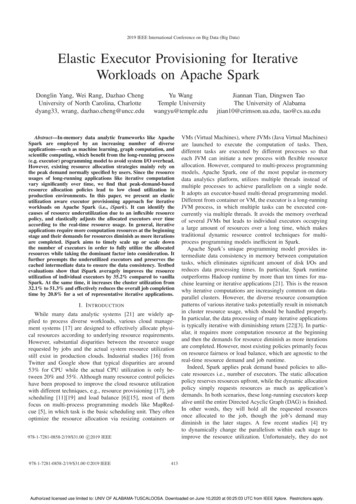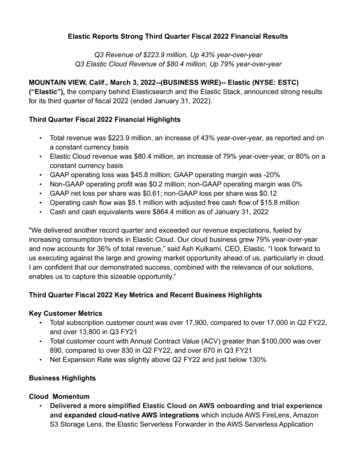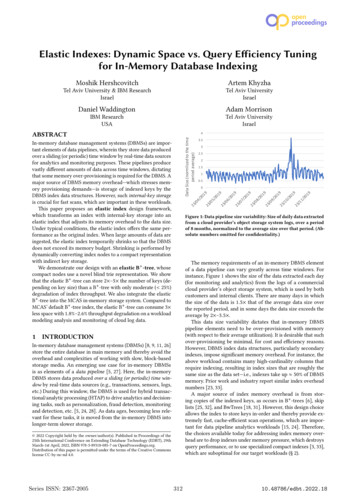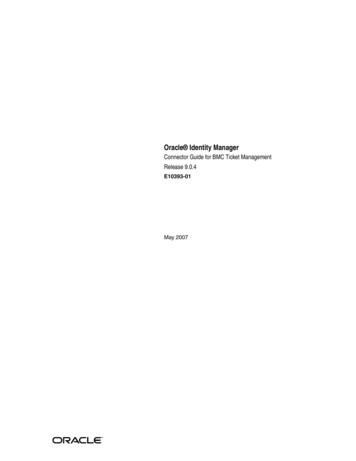
Transcription
2019 IEEE International Conference on Big Data (Big Data)Elastic Executor Provisioning for IterativeWorkloads on Apache SparkDonglin Yang, Wei Rang, Dazhao ChengUniversity of North Carolina, Charlottedyang33, wrang, dazhao.cheng@uncc.eduYu WangTemple Universitywangyu@temple.eduAbstract—In-memory data analytic frameworks like ApacheSpark are employed by an increasing number of diverseapplications—such as machine learning, graph computation, andscientific computing, which benefit from the long-running process(e.g. executor) programming model to avoid system I/O overhead.However, existing resource allocation strategies mainly rely onthe peak demand normally specified by users. Since the resourceusages of long-running applications like iterative computationvary significantly over time, we find that peak-demand-basedresource allocation policies lead to low cloud utilization inproduction environments. In this paper, we present an elasticutilization aware executor provisioning approach for iterativeworkloads on Apache Spark (i.e., iSpark). It can identify thecauses of resource underutilization due to an inflexible resourcepolicy, and elastically adjusts the allocated executors over timeaccording to the real-time resource usage. In general, iterativeapplications require more computation resources at the beginningstage and their demands for resources diminish as more iterationsare completed. iSpark aims to timely scale up or scale downthe number of executors in order to fully utilize the allocatedresources while taking the dominant factor into consideration. Itfurther preempts the underutilized executors and preserves thecached intermediate data to ensure the data consistency. Testbedevaluations show that iSpark averagely improves the resourceutilization of individual executors by 35.2% compared to vanillaSpark. At the same time, it increases the cluster utilization from32.1% to 51.3% and effectively reduces the overall job completiontime by 20.8% for a set of representative iterative applications.I. I NTRODUCTIONWhile many data analytic systems [21] are widely applied to process diverse workloads, various cloud management systems [17] are designed to effectively allocate physical resources according to underlying resource requirements.However, substantial disparities between the resource usagerequested by jobs and the actual system resource utilizationstill exist in production clouds. Industrial studies [16] fromTwitter and Google show that typical disparities are around53% for CPU while the actual CPU utilization is only between 20% and 35%. Although many resource control policieshave been proposed to improve the cloud resource utilizationwith different techniques, e.g., resource provisioning [17], jobscheduling [11][19] and load balance [6][15], most of themfocus on multi-process programming models like MapRedcue [5], in which task is the basic scheduling unit. They oftenoptimize the resource allocation via resizing containers orc978-1-7281-0858-2/19/ 31.00 2019IEEE978-1-7281-0858-2/19/ 31.00 2019 IEEEJiannan Tian, Dingwen TaoThe University of Alabamajtian10@crimson.ua.edu, tao@cs.ua.eduVMs (Virtual Machines), where JVMs (Java Virtual Machines)are launched to execute the computation of tasks. Then,different tasks are executed by different processes so thateach JVM can initiate a new process with flexible resourceallocation. However, compared to multi-process programmingmodels, Apache Spark, one of the most popular in-memorydata analytics platform, utilizes multiple threads instead ofmultiple processes to achieve parallelism on a single node.It adopts an executor-based multi-thread programming model.Different from container or VM, the executor is a long-runningJVM process, in which multiple tasks can be executed concurrently via multiple threads. It avoids the memory overheadof several JVMs but leads to individual executors occupyinga large amount of resources over a long time, which makestraditional dynamic resource control techniques for multiprocess programming models inefficient in Spark.Apache Spark’s unique programming model provides intermediate data consistency in memory between computationtasks, which eliminates significant amount of disk I/Os andreduces data processing times. In particular, Spark runtimeoutperforms Hadoop runtime by more than ten times for machine learning or iterative applications [21]. This is the reasonwhy iterative computations are increasingly common on dataparallel clusters. However, the diverse resource consumptionpatterns of various iterative tasks potentially result in mismatchin cluster resource usage, which should be handled properly.In particular, the data processing of many iterative applicationsis typically iterative with diminishing return [22][3]. In particular, it requires more computation resource at the beginningand then the demands for resource diminish as more iterationsare completed. However, most existing policies primarily focuson resource fairness or load balance, which are agnostic to thereal-time resource demand and job runtime.Indeed, Spark applies peak demand based policies to allocate resources i.e., number of executors. The static allocationpolicy reserves resources upfront, while the dynamic allocationpolicy simply requests resources as much as application’sdemands. In both scenarios, these long-running executors keepalive until the entire Directed Acyclic Graph (DAG) is finished.In other words, they will hold all the requested resourcesonce allocated to the job, though the job’s demand maydiminish in the later stages. A few recent studies [4] tryto dynamically change the parallelism within each stage toimprove the resource utilization. Unfortunately, they do not413Authorized licensed use limited to: UNIV OF ALABAMA-TUSCALOOSA. Downloaded on June 10,2020 at 00:25:03 UTC from IEEE Xplore. Restrictions apply.
2fundamentally address the underutilization problems when thelong-running application requires time-varying resources. Thisdisparity causes the formation of idle resources, producinginefficient cluster resource usage and an inability to provisioncomputing services.Many existing studies [11][3][10] have shown that dynamically tuning resources at runtime can effectively utilize computation resources and reduce resource contention.However, it is challenging to exploit time-varying resourcedemands of various iterative workloads on Apache Spark.First, resource allocation would be counterproductive whilelacking accurate accounting information of the resource usagein the default system. Most existing schedulers [9] assignresources based on the peak demand estimation, which cannot capture the real-time resource usage and further leadto resource underutilization. In contrast, an ideal schedulershould provision cluster resources in a timely manner if anyresource under-utilization is detected during runtime. However,it is still difficult to decide the number of allocated executorsand which executor to be evicted from the running list facingtime-varying multi-resource demand across different stages.Second, it is necessary to ensure the data consistency whenapplying elastic resource scheduling strategies, e.g. addingand removing executors. In particular, removing running executors directly may cause the re-computation of lost data,which is a significant overhead to in-memory data analyticscomputation. To tackle the aforementioned challenges, wepresent an automated utilization aware executor provisioningapproach for long-running iterative workloads on ApacheSpark (i.e., iSpark). It monitors the real-time resource usagefor individual executors and flexibly scales up or down theallocated resources to best fit the application’s demand, i.e.,minimizing the resource slack in the cluster. iSpark furtherpreserves the cached intermediate result on the underutilizedexecutors before removing them to ensure consistency. Thispolicy can effectively avoid the additional overhead causedby implementing the scaling down decisions. Specifically, thispaper makes the following contribution1 : We empirically study and demonstrate the time-varyingresource demand of iterative workloads running onApache Spark. We find that the demands for resourcesof iterative applications are high at the beginning stagewhile diminishing in the later stages as more iterationsare completed.We propose iSpark, an elastic executor managementframework compatible with Apache Spark. It monitorsthe real time resource usage and adjusts the allocatedresource strategically at runtime to capture varying workload demands and improve cluster utilization.We design and implement a new component with adaptivepolicy to preempt the underutilized executors gently. Itpreserves the cached intermediate data from underutilizedexecutors to ensure the data consistency.1 Thesource code is available at https://github.com/Young768/iSpark.We evaluate iSpark based on the representative workloadsfrom HiBench [8]. Our results demonstrate that iSparkimproves cluster’s CPU utilization by 29% compared todefault Spark resource allocation policies and effectivelyreduces the overall job completion time 20.8%.The rest of this paper is organized as follows. Section IIgives background and motivations on resource allocation.Section III describes the detailed system design and embeddedresource scheduling algorithm. Section IV presents experimental results. Section V reviews related work. Section VIconcludes the paper. II. M OTIVATIONA. BackgroundSpark currently applies two peak demand based policies(i.e., static and dynamic allocation models) to allocate resources for task execution. In the mode of static allocation,users control the amount of application resource by configuring the number of executors. The application reserves CPUand memory resources over the full job duration. The dynamicallocation can only increase the number of executors simplyto meet the peak demand of workloads until it reaches theupper number set by users. Note that the executor can exitonly when the corresponding process becomes idle in bothscenarios. Obviously, these peak demand based strategies inApache Spark may lead to severe resource wastage when theapplication’s resource usage varies significantly in differentstages. Extremely, the idle executors are not allowed to be shutdown because of the cached intermediate data on them. Otherwise, it will incur additional overhead by re-computation [2].Thus, a more fine-grained and holistic design is expected forthose iterative applications with diminishing resource demand.B. Empirical StudyTo quantify the time-varying resource demand of iterativeworkloads, we profile the resource usage of executors by usingthe benchmark from HiBench [8]. We conducted a case studybased on a 9-nodes cluster, where 8 nodes serve as slavenodes and one serves as master node. We configured that eachexecutor with 2 GB memory and one CPU core. We repeatedeach experiment for 10 times and collected the average data.1) Diminishing Demand of Iterative Processing: Firstly,we study the resource demand nature of iterative applicationsunder the default static resource allocation policy. In theexperiment, we set the number of executors to be 8. We rana number of iterative applications provided in HiBench [8],including LDA, SVM, PageRank and KMeans. Figure 1(a)shows the accumulative job progress achieved with the statically allocated resources. The result also shows that it takes20% time for the SVM job to achieve progress by 90%,and 80% time to further finish training. The other threeapplications also exhibit similar features: the first severaliterations generally boost the job progress very quickly. Thesefeatures can be explained as the law of diminishing return,which has been applied in many other data analytic systemsin addition to machine learning [22]. It implies that the414Authorized licensed use limited to: UNIV OF ALABAMA-TUSCALOOSA. Downloaded on June 10,2020 at 00:25:03 UTC from IEEE Xplore. Restrictions apply.
Executor NumberJob lative Time %M30(a) Accumulative Job Progress.(b) Accumulative of CPU Usage.150150Used500exe010051015Time (stage)2025(c) Number of Executor.Unused100200100NCPU Usage(%)40100CPU Usage(%)3exe1exe2Stage Mexe3Used100Unused500exe0exe1exe2Stage Nexe3(d) CPU Utilization.Fig. 1. Empirical study results of iterative job progress analysis, accumulative CPU usage and time-varying CPU utilization on executors.iterations in later stages may result in marginal performanceif still given the same amount of computational resources.To further demonstrate our observations, we collect the realtime CPU utilization trace of the cumulative CPU usageacross all machines, which is illustrated in Figure 1(b). Theresults confirm that the CPU usage for iterative application isquite high at the beginning, which is nearly close to 80%.As the iterative processes going on, the CPU usage dropsto below 30%. The above observations demonstrate that thedefault resource allocation is inefficient as they are agnosticto the actual resource demand within each job. Thus, wefind an opportunity here that deallocating the resources fromthese applications in the later stages may not affect theirperformance but result in higher resource efficiency.2) Underutilized Executors: We further enabled the dynamic allocation policy and set the maximum number ofexecutors to be 32. We depicted the number of executorsagainst time in Figure 1(c) and recorded the correspondingaverage CPU utilization at time M and N in Figure 1(d). Itshows that the number of executors increased exponentiallyat the beginning stage until it reached the upper bound. Thedynamic allocation policy allows Spark to request executors inrounds (i.e. stages), which is triggered when there are pendingtasks backlogged for more than the duration set by user. Theresult in Figure 1(c) also demonstrates the effectiveness ofsuch scaling up resource control policy. Figure 1(d) showsthe average CPU usage at time M and N on four selectedexecutors for PageRank application. The result illustrates thatthe average CPU usage achieves nearly 70% at stage M.However, the average CPU usage decreases to 30% at stageN, which is lower than half of peak value at stage M. Thenumber of executors remained the same even though thereare under-utilized nodes, e.g., exe2 and exe3. These resultsdemonstrate that the current dynamic allocation policy cannotevict the under-utilized nodes effectively and lead to severeresource fragmentation and wastage. A key observation is thatthe number of allocated executors should be reduced whenthere are under-utilized nodes. The utilization of individual executors should be improved and then the deallocated resourcescan be released or utilized by other applications co-hosting inthe cluster.C. Motivation of Elastic ProvisioningThe above observations motivate us that the number of allocated executors should be dynamically tuned during runtime toAPP-1UnusedAPP-1Executor1 Task-1 Task-3Executor1 Task-1Executor2 Task-2Executor2 Task-2Executor3 Task-3Executor3 APP-2Executor4 Task-4Executor4 APP-2(a) Peak Demand Base AllocationAPP-2Task-4(b) Utilization Aware AllocationFig. 2. A toy example shows different allocation policies.avoid the resource wastage. This work focuses on the scalingdown policy to handle the under-utilized problem in the laterstage of iterative job execution. We intuitively explain ourproposed scheme via a toy example in Figure 2. Note thatthe current dynamic allocation policy only starts to removeexecutors if there is no running tasks and cached data on theexecutor. The parallelism of the computation will maintain theinitial setting during the runtime. However, for cases where thecomputation in the later stage requires less resources, it willnot remove the corresponding executors (e.g. Executor 3 and4 in Figure 2(a)) though their utilizations are quite low. This isbecause of the fact that running tasks and cached data are stillon these underutilized executors. To overcome this problem,a more aggressive strategy is expected to combine the tasksrunning on the under-utilized Executor 3 and 4 into a singleone executor (i.e., Executor 1), resulting in two high-utilizednodes as shown in Figure 2(b). At the same time, the cachedintermediate data on Executor 3 and 4 should be preserved toensure the data consistency. Then these released resource (i.e.,Executor 3 and 4) can be utilized by other applications or shutdown for energy efficiency.III. S YSTEM D ESIGNA. Architecture OverviewFigure 3 shows the architecture of iSpark. It includes threecentralized components, i.e., iMetricCollector, iController andiCacheManager and two distributed mechanisms, i.e., Monitorand iBlockManager, which are implemented on each participating executor. The key functionality of iSpark is built on topof Apache Spark, which can timely scale up or scale downthe number of executors in order to fully utilize the allocatedresources while considering the multiple resource constraints.From the perspective of workflow, Spark usually launches adriver program together with a SparkContext object after job415Authorized licensed use limited to: UNIV OF ALABAMA-TUSCALOOSA. Downloaded on June 10,2020 at 00:25:03 UTC from IEEE Xplore. Restrictions apply.
WorkerDAGScheduler༇ iMetricCollector༄ MonitorBlockManageriControllerMaster4༈ ༅ 1) Problem Statement: For a given workload set, makespanis the duration between workload submission and completion.Equivalently, the makespan of applications can be minimizedif all available resources can be fully utilized by applicationsalong time. To achieve the above goal, iSpark aims to improvethe resource utilization at both application and cluster level inthis problem. In vanilla Spark, a user submits an applicationwith parallelism of m requesting n executors (normally n n Ri resources for am). Then the cluster manager allocatesExecutorAllocationManageriCacheManager༆ Metrics and DAG ĹCache managementķResource usageĺRDD preservation ĻTask rescheduling ļAllocation decisioniFig. 3. Architecture of iSpark.submssion. Within SparkContext, the proposed new component iController, iM etricCollector and iCacheManager areinstantiated along with existing components DAGSchedulerand ExecutorAllocationManager. Then, Spark driver launchesmultiple executors across the cluster based on the resourcedemand, which will result in Monitor being deployed oneach executor accordingly. We briefly describe the majorcomponents of the new mechanisms in iSpark. iMetricCollector collects the real-time information (e.g.CPU and memory metrics) and the operation logic information, i.e. RDD dependency, from DAG scheduler.Monitor will report the resources usage information ofcorresponding executors to iMetricCollector periodicallyvia the system heartbeat.iController makes the provisioning decisions based on themetrics provided by iMetricsCollector, which will furtherrequest ExecutorAllocationManager (EAM) to performthe provisioning decision in terms of the number ofexecutors.Centralized iCacheManager coordinates with iControllerto ensure the data consistency. iCacheManager is responsible for managing RDDs, which applies DAG-awarepolicy to preserve data partitions and updates the relatedRDD information to DAG scheduler.Distributed iBlockManager replicates the data blocks onthese executors to be removed based on the provisioning decision and the DAG-aware policy provided byiCacheManager.B. Utilization Aware Executor ProvisioningThe resource provisioning policy embedded in iControlleraims to minimize the number of allocated executor, and satisfythe application’s demand at the same time. The dynamicprovisioning procedures of iSpark are based on the utilization information collected from the previous iterations of therunning application, which is provided by iM etricsCollector.We first formulate the proposed resource provisioning problemand then address it based on the bin packing problem. Wefinally transform the multi-dimensional bin packing probleminto the classic packing problem by using a dominant factorscheduling approach.specific iterative application (Ri is a multi-dimensional vector,with dimensions representing CPU and memory). We denoteri as the peak resource request of a task xi allocated on corresponding executor. Currently, vanilla Spark allocates resourcesfor applications based on their peak demands. Initially, then Ri }.allocated resource should satisfy that: G { xi ri iIn iSpark, we use ui to represent the estimated utilization of atask xi running on the hosting machine and Uj to represent theutilization of executor j. We estimate ui by using the historicalutilization informations from tasks running on workers andprovision sufficient resources at once based on the estimation.Once an application is submitted at t, let xij denote thattask i will be allocated on executor j and yj be an indicator,where yj represents that executor j is used. There are threeconstraints in the problem formulation as follows. First, atleast one executor should be allocated for the computationduring the job execution:1 n yj .(1)jSecond, iSpark keeps the same parallelism of the applicationfor the whole duration, which means the number of tasks orpartitions will not be changed during the whole runtime: xij yi m. i, j.(2)jiThird, the resource usage of each executor j should notexceed its capacity. Here, we denote a dynamic threshold (i.e.,min{θ, Umax }), which enables the system to automaticallyadjust its behavior depending on the workload patterns exhibited by the applications. θ represents each executor’s fixedcapacity, which is set as 100% by default. Umax is the highestusage of executor from previous iterations. This thresholdrepresents a trade-off between efficiency and performance. Onthe one hand, it mitigates the impact from skewness to makethe scheduling more efficient; On the other hand, it ensuresthat the system does not run out of resources. Each executor’sestimated resource usage is ui (t ti ) after the tasks have beenexecuted since ti . Thus, xij ui (t ti ) yi min{θ, Umax }.(3)iThe objective is formulated as below, which aims to maximizethe usage of these allocated executors, i.e, minimizing the416Authorized licensed use limited to: UNIV OF ALABAMA-TUSCALOOSA. Downloaded on June 10,2020 at 00:25:03 UTC from IEEE Xplore. Restrictions apply.
5number of executors to be assigned during the job execution.minn yi ,i 1(4)s.t. (1) (2) (3). Executor AExecutor BExecutor CExecutor AExecutor B(a) CPU Usage Executor C(b) Memory UsageFig. 4. An example of dominant factor from the view of CPU and memory.As the objective function and the constraint (3) are bothnonlinear, it is difficult and computationally expensive to solvethe problem directly. Thus, we introduce a heuristic algorithmas follows to tackle the aforementioned challenges.Algorithm 1 Adaptive provisioning1: update ui via heartbeat from monitor;2: sort Uj in decreasing order;3: if there are pending jobs and Uj γ then4:for task i in taskset do5:arg max Uj based on DFS;6:if Uj min{θ, Umax } then7:pack task i into executor j;8:update and sort Uj in decreasing order;9:remove xi from taskset;10:end if11:end for12: end if2) Adaptive Provisioning Policy: The optimization problemdefined in Equation (4) can be transferred to a bin packingproblem [20] with variable bin sizes and balls, where bins represent the executors and balls are the task set to be allocated.Bin sizes are available capacities of the executors and the sizeof balls corresponds to the resource usage of tasks. First, wedraw an analogy with the solution in a one-dimensional space(both balls and bins). An effective heuristic for such problemis to repeatedly match the largest ball to fit in the current bin.When no more balls fit, a new bin will be opened. Intuitively,this approach reduces the unused space in each bin (i.e.,reduces fragmentation in our problem) and therefore, reducesthe total number of bins used, which can be equivalent tominimizing executor number N and fully utilizing the existingbins. As the bin packing problem is NP-Hard, we then apply aBest Fit Decreasing Packing (BFDP) algorithm, which requiresno more than ( 119 OP T 1) [20] bins, where OP T is thenumber of bins provided by the optimal solution. To efficientlytrigger the algorithm, we introduce a lower bound γ, whichis chosen empirically based on the sensitivity evaluation inSection IV-D. As shown in Algorithm 1, iSpark adaptivelyadjusts resource provisioning when there are pending jobsin the queue and underutilized executors simultaneously. Foreach task to be scheduled, the algorithm tries to pack it intothe executor which has the least available capacity amongall eligible executors, to maximize Uj based on BFDP (asshown in line 5-8). If it can satisfy the capacity’s constraint(Eq. 3), the task will be packed into that executor directly.If not, the algorithm will keep searching for executor withenough available resources. After this, the executor will beclassified into two categories: receivers or givers. Givers aredefined as those executors who will give up their executionmission for the remaining stages and release the underutilizedresource according to the new placement decisions. Receiversare defined as running executors who will be oversubscribedby tasks from givers for the remaining iterations to fully useresource slack. The task assignment results (as shown in line7) and related Uj will be updated repeatedly until all the taskshave been scheduled.Unfortunately, BFDP algorithm typically focuses on solvingone-dimensional packing problem. To solve our problem formultiple resources, we transform the multi-dimensional binpacking problem into the classic packing problem by usingDominant Factor Scheduling (DFS) approach. For instance,if we simply apply BFDP algorithm to pursue an optimalnumber of executors to fully utilize CPU cores, it may betoo greedy and introduce high contention for other resources,such as memory. Intuitively, as shown in Figure 4, we usean example to explain how DFS works. There are threerunning executors, whose CPU usage are 30%, 30% and 10%,and memory usage are 40%, 45% and 20%, respectively. Ifwe schedule the resources by applying BFDP based on theCPU usage, the optimal solution would be to pack the tasksfrom both executors B and C into A, resulting in that theestimated utilization of executor A will be around 70% in thefollowing stages. However, from the perspective of memory,it is highly possible that the memory usage of executor Awill be overloaded (105%), causing the tasks failure in thefollowing stages, which is unacceptable. In this case, CPUis actually a soft constraint (task is slower than expectedwith higher resource usage), but memory should be a hardconstraint (task will fail due to Out of Memory). Thus, it isbetter to only pack the tasks from underutilized C into B tofully utilize the resources slack, avoiding the potential taskfailure. Correspondingly, B and C will be the receivers andgivers, respectively. In iSpark, the dominant factor is definedas the bottleneck resource when we pack the task sets intoexecutors, which ensures that our reallocation will not causetask failures. As shown in Line 5 of Algorithm 1 , we use themaximal utilization as the DFS for BFDP. Here, we definemaximal utilization as maximizing Uci (t), Umi (t) , whereUci (t) and Umi (t) are the used memory and CPU at time t.3) Resource Reprovisioning: Another concern is reclaiming resource slack aggressively (i.e., under-provisioning) maycause severe resource contention (with possible task failures). In particular, CPU provisioning can only tolerate over100% utilization in a short bursty duration and should beavoided. Thus, the resource reprovisioning is necessary whenthe average resource utilization keeps higher than h times417Authorized licensed use limited to: UNIV OF ALABAMA-TUSCALOOSA. Downloaded on June 10,2020 at 00:25:03 UTC from IEEE Xplore. Restrictions apply.
6CPU Utilization(%)120B overloaded 100 80Scaling down 60DAG A removed 4020Executor AExecutor B0 giver receiverƚCumulative TimeFig. 5. An overprovisioning example to motivate the reprovisioning operation.Fig. 7. An illustration of VIP policy: when stage m is finished, the futurestages have dependency on RDD A while no dependency on RDD B. Sopartition 1 is prioritized to be preserved from giver to receiver.4.preserve partitioniBlockManagerBMME5. RDD information3. preserve request6.remove executoriControlleriCacheManager1.initiate preservationiMetricCollector2.update metricsFig. 6. Overview of RDD preservation workflow in iSpark.of the expected upper threshold for one monitoring epoch.For example, as shown in Figure 5, the CPU usages of bothexecutor A and B are underutilized before time t. However,the scaling down policy leads the executor overloaded afterthe executor A is removed directly at time t. To avoidthese cases, we set h to 1.1 for CPU usage specifically,which is experimentally determined to balance applicationperformance and resource utilization. The detailed sensitivityanalysis is discussed in Section IV-D. In each provisioninginterval, we update the threshold min {θ, Umax } based on thelatest information. To prevent disastrous task failures causedby resource demand variation, the reprovisioning action isrequired if any executor’s actual utilization is larger thanh min {θ, Umax }. Then iSpark requests one more executorsby extending the existing scaling up policy. This heuristicallows iSpark to quickly correct resource provisioning decisionto avoid overloaded workers.C. Preempt Executors Gently1) Data Consistency in iSpark: Due to the consistencysemantics of RDD, if any intermediate data from previousiterations has not finished or been lost (due to removingrunning executors), Spark will not automatically use the
outperforms Hadoop runtime by more than ten times for ma-chine learning or iterative applications [21]. This is the reason why iterative computations are increasingly common on data-parallel clusters. However, the diverse resource consumption patterns of various iterative tasks potentially result in mismatch










